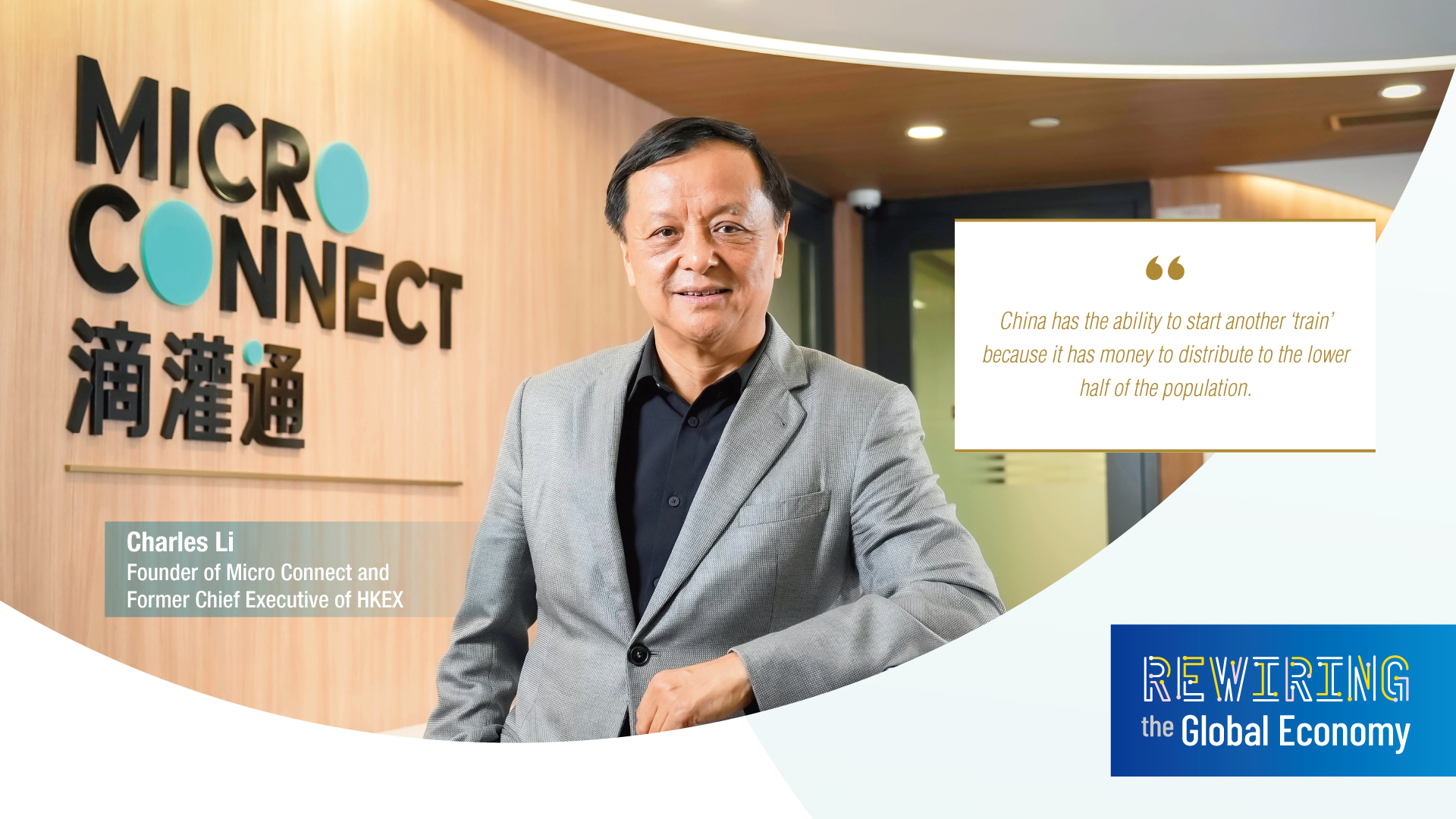
With a commitment to reshaping global trade dynamics and fostering equitable growth, Charles LI, Founder of Micro Connect and former Chief Executive of HKEX, is pioneering initiatives to support small businesses and enhance financial inclusivity in China.
Numerous metrics can explain the complexities of global trade, yet fundamentally, the system resembles a series of loops linking buyer and seller. Manufactured goods and commodities flow in one direction, payments travel the opposite way, and investments follow paths designed to generate returns on capital.
However, escalating tensions between China and the US are set to disrupt the major trade patterns established over the past 30 years. These patterns have ushered in new prosperity for millions in developing countries, kept prices low in large consumer economies, and allowed financial markets to function effectively.
Now, doubt and uncertainty prevail. Solutions must be sought through new engines of growth. In Asia, this can be achieved by building or strengthening alternative trade loops, deploying breakthrough technologies to drive new industries, and maximizing the potential created by digital commerce and innovative financial systems.
A Call for New Strategies
“We have seen a period of great transformation during which China became the factory of the world,” said Charles Li, former Chief Executive of Hong Kong Exchanges and Clearing (HKEX) and more recently the Founder of Micro Connect, an initiative providing financial support for small businesses that struggle to secure capital. “We are now beginning to see the impact of that on the main stakeholders’ respective systems and their domestic economic structures. It is something that has been coming for a long time, but which people did not take particularly seriously until now.”
Li summarized key factors, including the “hollowing out” of the US industrial base, which has led to increasing dependence on manufacturing in other countries. This trend has boosted the profits of US importers, propelled Wall Street to new highs, and ensured that money reinvested by overseas exporters flows into US Treasuries to fund the credit cycle.
Costs and Consequences
China, in turn, has benefited from surging export earnings, but there are significant costs. These can be measured in various ways, including the consequences for the rural population, environmental impacts, and an uneven distribution of prosperity. Unlike the US, the Chinese government has retained a sizable share of wealth to reinvest in industry, bolster foreign exchange reserves, or lend to other countries.
“At the root of the problem is how the wealth accumulated on both sides should be distributed. In the US, the globalization of manufacturing has weakened the domestic industrial base, undermining the government’s ability to generate tax revenue and redistribute wealth through social programs. On the other hand, after decades of rapid industrialization, China must now address structural imbalances left over from earlier stages of development, like environmental degradation and low wages for migrant workers,” Li said.
“That issue has caught up with us and caused the previous ‘musical chairs’ to stop. People argue that the US is a market economy and China is a planned economy, but that is a superficial look at the two outcomes. Regardless of the system, we all know the elite possess a much greater share of national wealth than ordinary people and have a much greater chance of success.”
The Path Forward
He noted that when the US talks about bringing manufacturing back home, the underlying issue is really about restoring a tax base, enabling state and federal governments to escape their debt trap.
This plan may or may not succeed. However, as the global economy resets, China’s priority must be to increase domestic consumption to compensate for declining exports. It must also be prepared to redistribute its accumulated wealth more broadly, ensuring that rural populations gain access to better education, healthcare, and social services, while addressing environmental debts.
Overall, Li emphasized that countries must brace for a period of restructuring and a somewhat lower level of economic activity. Yet there remains an underlying confidence that capital holders will find ways to adapt.
Financial Solutions for Small Businesses
“China has the ability to start another ‘train’ because it has money to distribute to the lower half of the population,” Li said. “Financial services play a vital role in assisting manufacturing, consumption and investment.”
Through the work of Micro Connect, Li is already helping to advance these developments. The company was established to facilitate revenue- based financing to small businesses, even at the grassroots level in rural China, to meet the practical needs as they seek growth.
The digitalization of finance has made this possible. The services offered are more inclusive, featuring efficient payment systems, risk management controls, and easy access for users of online platforms.
Li likened these services to vessels carrying blood through the human body, suggesting that capital is now reaching the most remote areas to enable local expansion and support new enterprises.
The revenue-based financing, often short-term and typically no more than three years, encourage businesses to grow “a vegetable not a tree”. This initiative is proving transformative for small communities and creating new avenues for larger institutions with spare capital to invest in such schemes.
A Cashless Future
“China is becoming a largely cashless society on the transactional payment side,” said Li, who also serves as the Chairman of Micro Connect (Macao) Financial Assets Exchange. The company’s pilot model connects investment capital with “small shops” and shares out agreed proceeds, attracting considerable interest.
“I thought why can’t investment be directed to reach small and micro enterprises, which have been underserved by the financial market? We don’t have to offer individuals in need of funding a ‘big’ product. We simply ask about their plans for the next year, agree on an amount, and reach a decision very quickly.”
The results thus far prove the value of digital systems in fostering a more localized concept of finance, based on a clear assessment of investment potential, risk, and projected daily cash flows. Everything operates on short timeframes, rapid response times, and a focus on achieving results in the near future.
Seizing Opportunities
“For a small business, it means that money can now come to you, rather than you having to come to the financial market,” Li said. “Currently, we are exploring additional ways to capture early- stage opportunities by expanding into post-revenue investments in established players. While everyone seeks the next Douyin or Tencent, many other companies can offer good portfolio returns. If they receive critical capital at the right time, they won’t die prematurely.”





